
Original Link: https://www.anandtech.com/show/854
ATI's SMOOTHVISION - The key to its "success"
by Anand Lal Shimpi on November 26, 2001 5:29 AM EST- Posted in
- GPUs
During Comdex week we brought you an article entitled: ATI's Radeon 8500 - New drivers expose potential. It was indeed those drivers (v6.13.10.3286 for Windows XP) that exposed some of the potential of ATI's Radeon 8500 core. The chip was finally performing close to and in some cases faster than NVIDIA's GeForce3 Ti 500.
Although some bugs still remained in the drivers, they were overall met with very positive response from end users and reviewers alike - us included. One of the most important features that were enabled with these latest Radeon 8500 drivers was ATI's anti-aliasing algorithm, which they call SMOOTHVISION.
When we originally brought you our preview of the Radeon 8500 we were thoroughly impressed by the potential that SMOOTHVISION offered being a programmable pseudo-random multisampling AA algorithm. The theory behind SMOOTHVISION was that its sampling pattern would produce higher quality anti-aliasing with a lesser performance hit than NVIDIA's offering because of its superior design. With this feature now fully supported under the latest drivers we were finally able to test ATI's claims and walked away thoroughly impressed with the solution.
To recap, here's a shot of the Radeon 8500 with its 2X AA enabled compared to NVIDIA's Quincunx:
|
ATI
Radeon 8500
AA Off 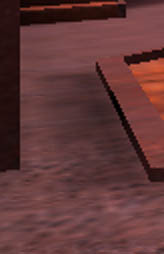 |
ATI
Radeon 8500
2X Performance AA 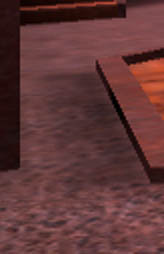 |
NVIDIA
GeForce3 Ti 500
Quincunx AA 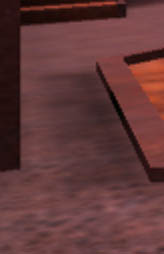 |
As you can clearly see, the textures on the Radeon 8500 image are much clearer than the GeForce3 Ti 500 image which was attributed to ATI's superior AA algorithm. But before we go on, let's compare the Radeon 8500 to another video card we happened to have laying around the lab:
|
ATI
Radeon 8500
2X Performance AA  |
The
Mystery Card 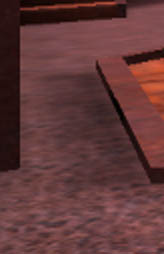 |
Here, the blurred textures of the GeForce3 are no where to be found and it's very difficult to tell the two solutions apart. Could it be that we have found a video card with AA capabilities that rival SMOOTHVISION?
Indeed we have, and that card is none other than the year-old NVIDIA GeForce2 GTS. Confused? Read on to find out exactly what's behind the crisp textures of SMOOTHVISION.
Supersampling rises from the dead
Before we go any further it is very important that you understand a bit about the various forms of anti-aliasing. Without touching the issue of sampling patterns there are two major types of AA currently in use: supersampling and multisampling.
Supersampling was introduced with the NVIDIA GeForce2 and ATI's Radeon over a year ago and it achieves the AA effect by rendering the scene at a higher resolution (by some fixed factor in the x and y directions), taking color samples from all of the additional pixels generated at this higher resolution, blending them together and finally forming an anti-aliased image at the native screen resolution. For example, one method used to implement a 4X supersampled AA algorithm was to render at 2X the horizontal and 2X the vertical resolution meaning that at a native screen resolution of 1024 x 768 the supersampled buffer would have the same number of pixels as a 2048 x 1536 image.
This method of anti-aliasing produced excellent results from a visual standpoint however the penalty was an incredible performance hit. By forcing the GPU to render 4X as many pixels as the native scene required, these cards incurred a significant fill rate and memory bandwidth hit that made AA at resolutions greater than 800 x 600 and usually 640 x 480 useless. It was clear that today's and even tomorrow's video cards wouldn't have enough power to make supersampled AA a reality and thus the need for something more efficient was born.
With the introduction of the GeForce3, NVIDIA had produced a core that was specifically designed around a more efficient form of AA - multisampling. The true benefit of multisampling is the achievement of high quality edge anti-aliasing (removal of "jaggies") at the sacrifice of increased texture blurring. The way multisampling works is very similar to supersampling in that a certain number of samples are taken in the x and y directions to be used as subpixels for the final image. The difference is that the color of these subpixels is not determined by actually sending these additional pixels through the pixel pipelines, instead the color of the subpixels is determined by original pixels. This reuse of texture data results in two things that set it apart from supersampling:
1) a significant reduction in the amount of texture memory bandwidth required to enable AA
2) introduction of blurred textures because of the reuse of texture color data
Although the GeForce3 core supports both supersampling and multisampling, the currently available drivers only support multisampling which is by far the most efficient method of AA on the GeForce3. We incorrectly assumed that the 4X AA mode on the GeForce3 was using the supersampling capabilities of the core and thus labeled it as so in our last article.
With the realization of this and another clue in hand we began to question our conclusions as to what was causing the superior texture quality of SMOOTHVISION.
The second clue
The Radeon 8500 performed very well with 2X AA enabled in our previous review and in many cases it was able to outperform the GeForce3 Ti 500 with Quincunx enabled. Yet for some reason, the Radeon 8500's performance was killed when SMOOTHVISION was set to its 4X mode. Enabling 4X AA on the GeForce3 Ti 500 resulted in a performance hit that was noticeable but no where near the drops we saw on the Radeon 8500.
Take this performance comparison below to illustrate exactly what we're talking about:
|
While the Radeon 8500 is very competitive in all of its 2X modes, enabling 4X cuts the frame rate in half while the the Ti 500 takes only a 9 fps hit; both cards were originally running at close to 100 fps.
With these questions in hand as well as issues with the edge anti-aliasing quality of SMOOTHVISION's performance mode that we brought up in the original article, we went to ATI at Comdex and discussed what we saw.
Answer 1: SMOOTHVISION uses Supersampling
If SMOOTHVISION were a multisampling AA algorithm then its sampling pattern could in no way result in the extremely sharper textures we saw in our previous review. The key word in that sentence is if; as we found out in our meeting with ATI, SMOOTHVISION is in fact a supersampling AA algorithm and does not use multisampling as we had originally assumed. While we could swear it was originally presented to us as a multisampling solution (that would explain how every other website out there has it listed as a multisampling AA algorithm), ATI insisted that they never mentioned it as either a super or multisampled solution - just a pseudo random-sampling AA algorithm.
Supersampling explains quite a bit about SMOOTHVISION; it explains why we were able to attain similar image quality from a GeForce2 GTS (and a Radeon DDR for that matter) and it explains why the Radeon 8500 takes such a large hit with 4X AA enabled (supersampling requires much more bandwidth than multisampling, the more samples you must take the more the bandwidth gap increases).
But what about GeForce3 users that are willing to take the performance hit to get the same crisp textures that GeForce2 and Radeon 8500 owners are granted? The answer to this is simple; we mentioned earlier that additional filtering could be used to reduce the blurring impact of multisampling - anisotropic filtering does just that.
When enabled on the lowest level supported by the GeForce3 (enabled through NVMax, a great utility for NVIDIA card owners), the resulting image with Quincunx AA can be found below (Note: since these screenshots are so small we'd suggest setting your screen resolution to no greater than 1024 x 768):
|
ATI
Radeon 8500
2X Performance AA  |
NVIDIA
GeForce3 Ti 500
Quincunx AA  |
NVIDIA
GeForce3 Ti 500
Quincunx AA + Level 2 Aniso 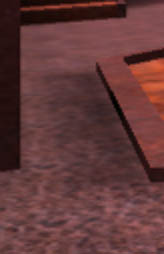 |
It seems as if the pseudo random sampling nature of SMOOTHVISION does not yield any visual benefits as the vast majority of the quality produced by the algorithm is due to its supersampling nature. The real question here is which performs better: Radeon 8500 with SMOOTHVISION or the GeForce3 Ti 500 with AA and anisotropic filtering?
Let's put that question on hold as we look at another issue that turned up while examining the quality of SMOOTHVISION.
Answer 2: "Performance" mode uses fewer samples
There were two issues of quality that we brought up with ATI in regards to their latest driver release. The first was a question as to why the sky in Quake III Arena looked so blotchy compared to what it should look like. We had assumed it was because ATI was auto-compressing textures and unfortunately ATI couldn't get us an answer in time for this article. The second question was in regards to the actual edge AA quality of SMOOTHVISION's "performance" mode.
To quote our previous article, "However, you can also clearly see that NVIDIA's 4X solution is better at reducing the infamous "jaggies" than ATI's 4X performance solution."
We went to ATI asking exactly why this was and the answer we received indicated that it was a difference in the sampling or filtering used by the "performance" AA mode. ATI was obviously reluctant to give out too much information about what the true differences between the "performance" and "quality" AA modes in order to protect their technology from competitors. Truthfully however it is pretty easy to find out much more information about a particular AA mode given the right type of screen.
Take this screen shot from Serious Sam for example:
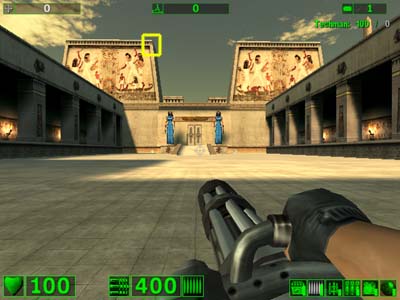
We zoomed in on the area enclosed by the yellow box and here's what we found (Note: since these screenshots are so small we'd suggest setting your screen resolution to no greater than 1024 x 768):
|
ATI
Radeon 8500
AA Off  |
ATI
Radeon 8500
2X Performance AA  |
ATI
Radeon 8500
2X Quality AA  |
You can clearly count the number of steps along the right side of the structure and in theory, the number of steps should increase as you take more AA samples. Now notice the difference between the screenshot with AA turned off and ATI's 2X performance mode; that's right, there is none. Look at the edge in the 2X Quality AA shot, see how smooth it is?
Could it be that ATI is not actually enabling AA in their performance mode? That wouldn't make much sense since we did see some evidence of AA in the previous review. Let's dig a little deeper.
|
ATI
Radeon 8500
AA Off  |
ATI
Radeon 8500
4X Performance AA 
|
ATI
Radeon 8500
4X Quality AA 
|
In the 4X AA mode the difference is much less pronounced, it still appears as if there is a difference in the number of samples between the Performance and Quality AA modes although both are supposed to be "4X" modes.
|
ATI
Radeon 8500
AA Off  |
ATI
Radeon 8500
2X Performance AA  |
ATI
Radeon 8500
2X Quality AA  |
The above shots are taken from the same exact scene, but now looking along an edge perpendicular to the original edge we were examining. Here you can see that in the 2X performance AA shot there are approximately twice as many steps along the bottom of the wall as in the original shot with AA turned off. The only difference between the performance AA and quality AA modes here is that the quality AA mode looks better, but it's clear both modes are anti-aliased.
|
ATI
Radeon 8500
AA Off  |
ATI
Radeon 8500
4X Performance AA  |
ATI
Radeon 8500
4X Quality AA  |
In 4X mode there is absolutely no difference between the Performance and Quality AA modes in terms of edge anti-aliasing here.
What does this prove? The only conclusion we can come to is that in the performance mode there are fewer samples being taken than in the quality mode meaning that 2X "performance" and 2X "quality" (the same applies to both 4X modes) aren't both 2X sampling modes.
ATI vs. NVIDIA: 2X AA Quality
With a better understanding of SMOOTHVISION we can now revisit the issue of AA quality, let's go to the screenshots (Note: since these screenshots are so small we'd suggest setting your screen resolution to no greater than 1024 x 768):
|
ATI
Radeon 8500
AA Off  |
NVIDIA
GeForce3 Ti 500
AA Off  |
With AA turned off, the screenshots look identical; they are both equally blurry and aliased.
|
ATI
Radeon 8500
2X Performance AA  |
ATI
Radeon 8500
2X Quality AA 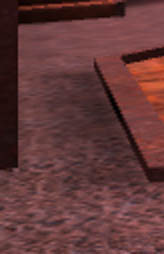
|
|
NVIDIA
GeForce3 Ti 500
2X Multisampled AA + Aniso 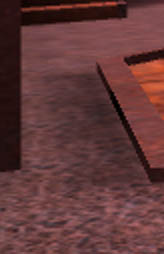
|
NVIDIA
GeForce3 Ti 500
Quincunx Multisampled AA + Aniso 
|
Because of the GeForce3's use of multisampling it needs to have anisotropic filtering enabled to level the playing field, this also reduces performance a bit as you will see in the performance section of this review. Because of ATI's supersampling and NVIDIA's anisotropic filtering, the texture clarity of the shots look very similar. We can tell some of the differences in edge AA quality (if you look closely you can see that the quality AA mode and both of NVIDIA's modes actually take more samples along the topmost platform) but in order to better see the differences we'll have to consult our Serious Sam screenshots:
|
ATI
Radeon 8500
2X Performance AA 
|
ATI
Radeon 8500
2X Quality AA 
|
|
NVIDIA
GeForce3 Ti 500
2X Multisampled AA + Aniso 
|
NVIDIA
GeForce3 Ti 500
Quincunx Multisampled AA + Aniso 
|
Here we can easily see that the edge AA quality of ATI's 2X performance AA mode is inferior to NVIDIA's 2X mode. If our hypothesis about ATI not rendering as many samples in their performance mode is true then it would explain why. ATI's 2X quality mode is very similar to both of NVIDIA's AA modes depicted here and falls in-between the two.
2X AA Conclusion: With anisotropic filtering enabled, NVIDIA's 2X and Quincunx multisampled AA modes are significantly better than ATI's 2X Performance AA mode. But you must enable anisotropic filtering in order to gain this overall advantage, otherwise the only advantage is in edge anti-aliasing at the sacrifice of blurrier textures. ATI's 2X Quality AA mode falls in-between NVIDIA's 2X and Quincunx modes in terms of edge AA quality and is easily just as good as both solutions with anisotropic filtering enabled.
ATI vs. NVIDIA: 4X AA Quality
We've already seen what the two cards look like with AA disabled so let's just jump straight into the screenshots (Note: since these screenshots are so small we'd suggest setting your screen resolution to no greater than 1024 x 768):
|
ATI
Radeon 8500
4X Performance AA 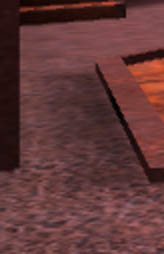 |
ATI
Radeon 8500
4X Quality AA 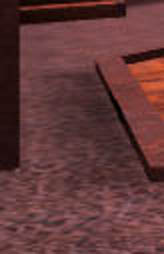 |
NVIDIA
GeForce3 Ti 500
4X Multisampled AA + Aniso 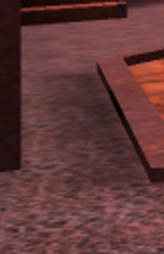
|
Again we see that it takes the enabling of anisotropic filtering to bring the GeForce3's texture quality up to par, but doing that does the trick as we don't see any clear differences between the texture quality in the three shots from above. We can get some indication of edge AA quality from these shots; if you look at the topmost platform the blurred AA samples in the 4X performance mode appear to be above the stairstep line where they should be. In the 4X quality and NVIDIA's 4X mode the samples appear just fine. Now let's have a look at edge AA quality in Serious Sam:
|
ATI
Radeon 8500
4X Performance AA 
|
ATI
Radeon 8500
4X Quality AA 
|
NVIDIA
GeForce3 Ti 500
4X Multisampled AA + Aniso  |
With 4X AA enabled it's much more difficult to tell any difference between the edge AA quality of the three screenshots although it's clear that the performance mode is definitely not as smooth as the quality mode or NVIDIA's 4X multisampled AA.
4X AA Conclusion: With anisotropic filtering enabled, NVIDIA's 4X AA is able to compete with ATI's 4X Quality AA in terms of texture quality and edge AA quality. ATI's 4X performance AA is not as good at anti-aliasing edges as NVIDIA's 4X mode.
Performance
To quickly sum up what we've concluded based on the image quality comparisons these are the performance comparisons we need to make:
ATI's 2X Quality AA vs. NVIDIA's 2X/Quincunx AA with Anisotropic
Filtering Enabled
ATI's 4X Quality AA vs. NVIDIA's 4X AA with Anisotropic Filtering Enabled
Our test platform has not changed since our previous article; we are still using the Athlon XP 1800+ on an EPoX KT266A board under Windows XP Professional. We used the following drivers:
ATI Drivers - v6.13.10.3286
NVIDIA Drivers - v21.85
|
Because it is forced to run with Anisotropic filtering enabled (although the lowest level supported) in order to offer competitive image quality, the Ti 500's frame rates are reduced a bit. If you compare these numbers with anisotropic filtering enabled to our previous review you'll realize that the hit for enabling anisotropic filtering is between 8 and 14% on the Ti 500. Even with anisotropic filtering enabled the Ti 500 is able to outperform the Radeon 8500 in every AA mode. Although we didn't include it because of poor edge AA quality, even the 2X performance mode doesn't change the performance picture much at all.
Where the Radeon 8500's supersampling AA really hurts it is with 4X AA enabled; its performance is virtually cut in half because it has to do twice the amount of work. Unfortunately with anisotropic filtering enabled, 4X AA is pushing it on the Ti 500 with frame rates clearly below the 60 fps level.
|
Again we see a similar picture; ATI's 2X quality AA remains competitive but the inefficiencies of supersampling AA become evident as 4X AA is enabled. Running at 1024 x 768 x 32 with 4X AA and Ansiotropic filtering enabled is a reality on the Ti 500 at 78 fps.
|
Since Max Payne wouldn't let us enable all of the AA modes we are left with Wolfenstein MP Test as our final performance measurement tool for this article. This will most likely be the final time we use the MP Test in an article as the full version of Return to Castle Wolfenstein has been released and it won't be long before we have an official set of demos we use in our reviews based on the final engine.
Wolf tells us the same story; ATI's 2X quality AA is competitive but their 4X AA isn't at all.
Final Words
This more thorough look at AA quality and performance raised some very interesting questions; at the top of our list is why ATI chose to go with supersampling AA for the Radeon 8500 and not a much more efficient multisampling implementation such as that found in NVIDIA's GeForce3. There are a couple of major reasons why ATI would make this decision:
1) Better texture quality without specifically enabling anisotropic filtering
2) Much easier to implement than multisampling
ATI either felt that the image quality benefits of supersampling outweighed the performance penalties or the Radeon 8500 was originally designed with multisampling AA in mind but the support ended up being broken in hardware after the chip taped out. We'll leave that up to you and ATI to decide, but with the amount of confusion in regards to ATI's SMOOTHVISION floating around it was necessary to provide some followup coverage.
Looking towards the future, ATI's next-generation core had better feature multisampling AA support if it is to remain competitive on all bases. As GPUs get more powerful and more efficient with memory bandwidth not only will rendering resolutions increase but the demand for efficient AA and other such features will as well.







